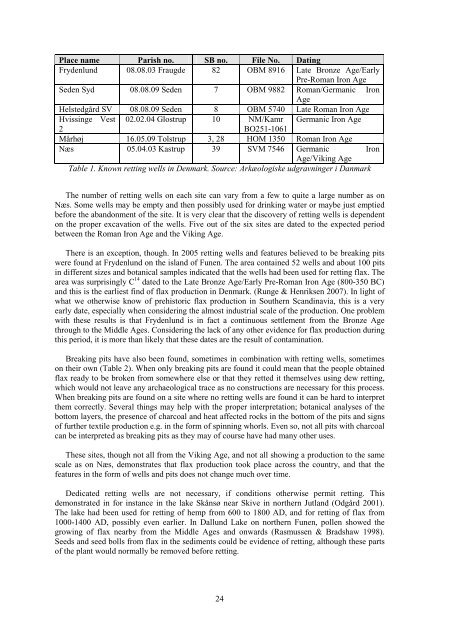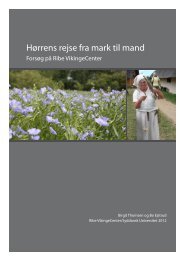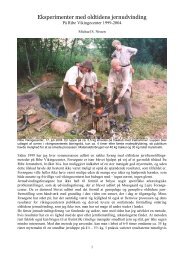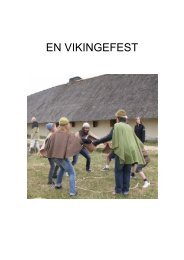From flax to linen. Experiments with flax - Ribe VikingeCenter
From flax to linen. Experiments with flax - Ribe VikingeCenter
From flax to linen. Experiments with flax - Ribe VikingeCenter
You also want an ePaper? Increase the reach of your titles
YUMPU automatically turns print PDFs into web optimized ePapers that Google loves.
Place name Parish no. SB no. File No. Dating<br />
Frydenlund 08.08.03 Fraugde 82 OBM 8916 Late Bronze Age/Early<br />
Pre-Roman Iron Age<br />
Seden Syd 08.08.09 Seden 7 OBM 9882 Roman/Germanic<br />
Age<br />
Iron<br />
Helstedgård SV 08.08.09 Seden 8 OBM 5740 Late Roman Iron Age<br />
Hvissinge Vest 02.02.04 Glostrup 10 NM/Kamr Germanic Iron Age<br />
2<br />
24<br />
BO251-1061<br />
Mårhøj 16.05.09 Tolstrup 3, 28 HOM 1350 Roman Iron Age<br />
Næs 05.04.03 Kastrup 39 SVM 7546 Germanic Iron<br />
Age/Viking Age<br />
Table 1. Known retting wells in Denmark. Source: Arkæologiske udgravninger i Danmark<br />
The number of retting wells on each site can vary from a few <strong>to</strong> quite a large number as on<br />
Næs. Some wells may be empty and then possibly used for drinking water or maybe just emptied<br />
before the abandonment of the site. It is very clear that the discovery of retting wells is dependent<br />
on the proper excavation of the wells. Five out of the six sites are dated <strong>to</strong> the expected period<br />
between the Roman Iron Age and the Viking Age.<br />
There is an exception, though. In 2005 retting wells and features believed <strong>to</strong> be breaking pits<br />
were found at Frydenlund on the island of Funen. The area contained 52 wells and about 100 pits<br />
in different sizes and botanical samples indicated that the wells had been used for retting <strong>flax</strong>. The<br />
area was surprisingly C 14 dated <strong>to</strong> the Late Bronze Age/Early Pre-Roman Iron Age (800-350 BC)<br />
and this is the earliest find of <strong>flax</strong> production in Denmark. (Runge & Henriksen 2007). In light of<br />
what we otherwise know of prehis<strong>to</strong>ric <strong>flax</strong> production in Southern Scandinavia, this is a very<br />
early date, especially when considering the almost industrial scale of the production. One problem<br />
<strong>with</strong> these results is that Frydenlund is in fact a continuous settlement from the Bronze Age<br />
through <strong>to</strong> the Middle Ages. Considering the lack of any other evidence for <strong>flax</strong> production during<br />
this period, it is more than likely that these dates are the result of contamination.<br />
Breaking pits have also been found, sometimes in combination <strong>with</strong> retting wells, sometimes<br />
on their own (Table 2). When only breaking pits are found it could mean that the people obtained<br />
<strong>flax</strong> ready <strong>to</strong> be broken from somewhere else or that they retted it themselves using dew retting,<br />
which would not leave any archaeological trace as no constructions are necessary for this process.<br />
When breaking pits are found on a site where no retting wells are found it can be hard <strong>to</strong> interpret<br />
them correctly. Several things may help <strong>with</strong> the proper interpretation; botanical analyses of the<br />
bot<strong>to</strong>m layers, the presence of charcoal and heat affected rocks in the bot<strong>to</strong>m of the pits and signs<br />
of further textile production e.g. in the form of spinning whorls. Even so, not all pits <strong>with</strong> charcoal<br />
can be interpreted as breaking pits as they may of course have had many other uses.<br />
These sites, though not all from the Viking Age, and not all showing a production <strong>to</strong> the same<br />
scale as on Næs, demonstrates that <strong>flax</strong> production <strong>to</strong>ok place across the country, and that the<br />
features in the form of wells and pits does not change much over time.<br />
Dedicated retting wells are not necessary, if conditions otherwise permit retting. This<br />
demonstrated in for instance in the lake Skånsø near Skive in northern Jutland (Odgård 2001).<br />
The lake had been used for retting of hemp from 600 <strong>to</strong> 1800 AD, and for retting of <strong>flax</strong> from<br />
1000-1400 AD, possibly even earlier. In Dallund Lake on northern Funen, pollen showed the<br />
growing of <strong>flax</strong> nearby from the Middle Ages and onwards (Rasmussen & Bradshaw 1998).<br />
Seeds and seed bolls from <strong>flax</strong> in the sediments could be evidence of retting, although these parts<br />
of the plant would normally be removed before retting.






